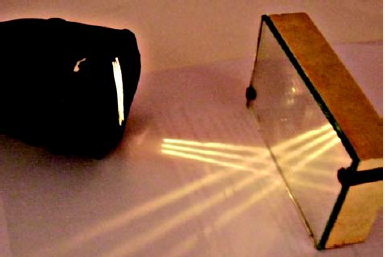Table of Contents
Activity 11.1- Observing Reflection of Light
Objective- To understand how light reflects off a plane mirror and changes direction.
Materials Needed-
- A torch (flashlight) with an option to create a narrow beam or slits to allow only a thin beam of light to pass.
- A plane mirror (a flat mirror without any curvature).
- A dark room or area to clearly see the light.
Procedure-

- Prepare the Torch- If your torch has a narrow beam setting, use that. If not, create slits using paper or cardboard to allow only a thin beam of light to escape from the torch.
- Darken the Room- Conduct this experiment in a dark or dimly lit room so that the light beam is clearly visible.
- Position the Mirror- Place the plane mirror on a table or any flat surface where it stands upright.
- Shine the Light- Turn on the torch and direct the thin beam of light towards the mirror. Aim the light at a slight angle, not directly perpendicular to the mirror.
- Observe the Reflection- Notice how the light beam hits the mirror and then bounces off in a different direction.
- Change Angles- Experiment by changing the angle at which the light beam hits the mirror and observe how the direction of the reflected light changes.
Also Check – Class 7 Science -Chapter 15 – Light- Complete Notes
Also Check – Chapter 11- A Detailed Guide to the Light Activities for Class 7 Students
Core Concepts Explained-
- Reflection of Light- When light rays hit a smooth surface like a mirror, they bounce back. This bouncing back of light is called reflection.
- Laws of Reflection- There are two main laws of reflection-
- The Angle of Incidence Equals the Angle of Reflection- The angle at which the light hits (incidence) the mirror is equal to the angle at which it bounces off (reflection).
- Incident Ray, Reflected Ray, and Normal Lie in the Same Plane- The incoming light ray (incident ray), the bounced light ray (reflected ray), and an imaginary line perpendicular to the mirror at the point of incidence (normal) all lie in the same flat surface or plane.
- Plane Mirror Characteristics- A plane mirror reflects light without distorting it, so the direction in which light is reflected changes depending on the angle at which it hits the mirror.
Possible Questions and Answers-
Why does the light change direction when it hits the mirror?
- Light changes direction upon hitting a mirror due to the law of reflection. The smooth surface of the mirror causes the light to bounce off at a specific angle.
Will the light reflect if I shine it straight at the mirror?
- Yes, it will reflect back along the same path. If the light beam is perpendicular to the mirror, the angle of incidence and reflection is 0 degrees.
What would happen if the mirror was not flat?
- If the mirror is curved (like a concave or convex mirror), the reflection would behave differently, bending the light in various ways and changing the image size and shape.